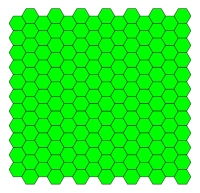REGULAR TESSELLATIONS
The three regular tessellations of the plane are closely related to the Platonic solids. Indeed, one can view the Platonic solids as regular tessellations of the sphere. This is done by projecting each solid onto a concentric sphere. The faces project onto regular spherical polygons which exactly cover the sphere. There are three possibilities:
| *442 | (3)p6m | *632p4m |
| {4, 4}
44 |
{3, 6}
36
|
{6, 3)
63
|
|---|
{3,3} Defect 180° |
 {3,4} Defect 120° |
 {3,5} Defect 60° |
 {3,6} Defect 0° |
 {4,3} Defect 90° |
 {4,4} Defect 0° |
 {5,3} Defect 36° |
 {6,3} Defect 0° |
| A vertex needs at least 3 faces, and an angle defect. A 0° angle defect will fill the Euclidean plane with a regular tiling. By Descartes’ theorem, the number of vertices is 720°/defect. |
|||
SaveSave











